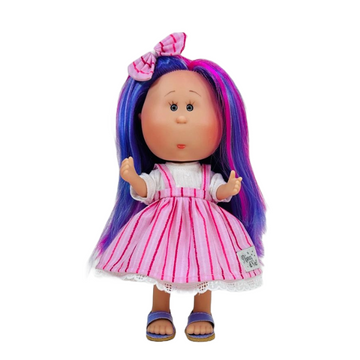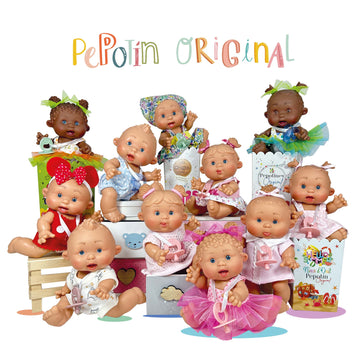Excitement About Dolls And Accessories
Table of ContentsAbout Dolls And AccessoriesNot known Factual Statements About Dolls And Accessories The Single Strategy To Use For Dolls And AccessoriesEverything about Dolls And AccessoriesDolls And Accessories for BeginnersThe Best Strategy To Use For Dolls And AccessoriesWhat Does Dolls And Accessories Mean?
When dolls are consisted of in group play, children practice waiting, sharing, and paying attention to others' ideas. Whether they're making believe to be a moms and dad, sibling, or good friend, children discover exactly how partnerships workhow to support others, solve disagreements, and treatment for someone else. These early role-play experiences come to be the foundation for healthy relationships and connections later in life.Duplicating soothing regimens with a doll (feeding, shaking, putting to bed) can help youngsters really feel calm and secure. Taking care of a doll can make a youngster feel qualified and confident.
Dolls And Accessories Fundamentals Explained
When youngsters see dolls that show their race, heritage, and culture, it strengthens a favorable feeling of identity. It claims, "You belong. Your tale issues." Dolls likewise present youngsters to cultures outside their very own, building respectful inquisitiveness and compassion for others. This is where comprehensive play can result in inclusive neighborhoods.
As Dr. Karyn Purvis, a leader in child advancement and trauma-informed care, once claimed: This effective quote highlights exactly how play isn't simply funit's exactly how youngsters discover ideal. The mind cords itself with rep. When a child is involved, happy, and psychologically linked to an activitylike doll playthe mind reinforces those links faster and much more meaningfully.
Dolls And Accessories - The Facts

Young boys require empathy, generosity, and imagination tooand doll play supplies that. Dolls are typically a youngster's very first "buddy," helping them practice connections, construct interaction skills, and feel comforted.
A Biased View of Dolls And Accessories
Through dolls that matter. Samantha Ong Samantha Ong is the owner of Joeydolls, a Canadian-based plaything brand on a mission to celebrate Oriental societies through happy, inclusive play. Influenced by her own experiences expanding up without social representation, Samantha designs dolls that help kids really feel happy of who they are while stimulating interest and compassion in others.
Playing with dolls motivates children to chat more regarding others' thoughts and feelings, a research study has actually located. The research study suggests that playing imaginary games with dolls could assist children create social skills, theory of mind and compassion.
What Does Dolls And Accessories Do?
They were likewise most likely to resolve the dolls in the second person, speaking to them straight, whereas the personalities on the computer system display they often tended to refer to in the 3rd person. No difference was observed between young boys and girls."Interior state language can show that a kid is considering various other individuals's thoughts and emotions while having fun with dolls," said Gerson.
Which they see language usage hereof is good verification of the hypothesis."Mardell included that the searchings for should put on any type of kind of role-play plaything, rather than being particular to Barbies. "I 'd take a more comprehensive view of what a doll is," he said." [It might be] any object that the kid can spend a feeling of various other into a stuffed animal, a stove glove that talks with them, or also an imaginary pal."Kid generally start to show indications of interior state language around the age of 4.
How Dolls And Accessories can Save You Time, Stress, and Money.
"It becomes vital for making and sustaining friendships, and just why not try here how they gain from their teachers, and parents."The research study additionally located that the children had actually boosted mind activity in the posterior remarkable temporal sulcus (pSTS) area when they talked as though their dolls had thoughts and feelings. The pSTS region is believed to be associated with the growth of social and emotional processing abilities.
Childhood years is not a fixed life phase; without a doubt, the definition, definition and understanding of youth are all based on modification. By the 19th century among one of the most profound adjustments was the relevance placed on enabling kids to experience "the carefree pleasures" of childhood years with playtime activities. Play was now thought about to be an essential element of a great youth.
In order to completely recognize the meaning of play, one have to additionally understand the significance of the doll. Dolls are a lot more than toys developed to delight young girls. Throughout the nineteenth century correct playtime activities were chosen to promote intellectual, physical or emotional growth. Dolls were especially popular since they were assumed to cultivate and nurture feminine qualities such as compassion, caring and compassion.
Dolls And Accessories Fundamentals Explained

It is only with archaeological examinations that scientists can wish to uncover and record the complete series of playtime experiences. Narrating these experiences, and specifically the role of dolls, is vital for presenting a more full image of childhood years during the 19th century. Alarcn, Sara E - baby dolls., "Child's Play: The Role of Dolls in 19th Century Childhood Years" (2007 )